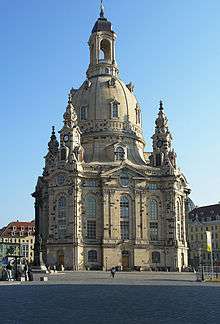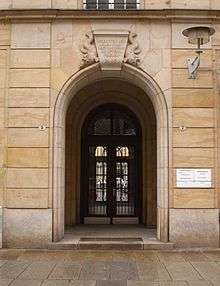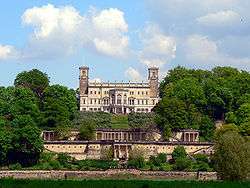Posta Sandstone
Posta Sandstone (German: Postaer Sandstein) also called Wehlen Sandstone (Wehlener Sandstein), only occurs on the eastern banks of the River Elbe at Alte Poste, near Herrenleithe, Wehlen, Zeichen and Posta. The thickness of the deposit is between 30 and 50 metres. It is also known as Überquader ("Over Ashlar") and has the smallest deposit of all the Elbe sandstones. [1] In 2008 it was being quarried in the areas around the village of Lohmen and in Wehlen.


Quarrying and use
In 2008 Posta Sandstone was being won in two quarries in the Wesenitz valley and it was being used for solid window and door frames, façade slabs, sculptor's blocks and high-profile masonry work. It is used especially in restoration work and sometimes also in new structures. The following is a selection of the structures built in Posta Sandstone:
- Berlin:
- Ground floor of the Berlin Institute of Technology in Charlottenburg
- Dresden:
- Old Town (Altmarkt) (rebuilding after the Second World War)
- Bismarck towers
- Dresden Bank buildings
- St. Anne's Church
- Eckberg Castle
- Dresden Central Station
- Cosel Palace
- Church of Our Lady
- Zwinger Palace, brown studio
- Albrechtsberg Palace, Dresden
- Hamburg:
- Villa Offen
- Magdeburg:
- Alte Wache
- Senftenberg
- War memorials for the dead of the First World War
- Art-historic use of Posta Stone
 Central station
Central station Albrechtsberg Castle, Dresden
Albrechtsberg Castle, Dresden- Eckstein Castle, Dresden
 Entrance to St. Anne's Church, Dresden
Entrance to St. Anne's Church, Dresden
See also
- List of sandstones
- Cotta Sandstone
- Reinhardtsdorf Sandstone
- Wehlen Sandstone
Sources
- W. Dienemann und O. Burre: Die nutzbaren Gesteine Deutschlands und ihre Lagerstätten mit Ausnahme der Kohlen, Erze und Salze, Enke-Verlag, Stuttgart 1929, p. 304ff
- Siegfried Grunert: Der Elbsandstein: Vorkommen, Verwendung, Eigenschaften. In: Geologica Saxonica Journal of Central European Geology 52/53 (2007), p. 143-204 (Digitalisat)
External links
References
- Dienemann/Burre: Die nutzbaren Gesteine Deutschlands, p. 306